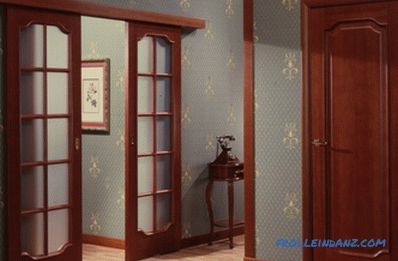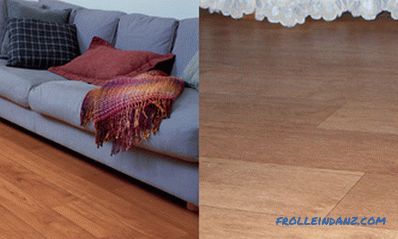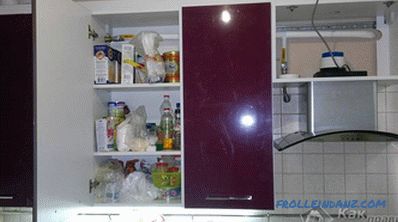The ceiling, painted with water-based paint or covered with wallpaper, is not very relevant today. In a modern interior, this surface is given no less attention and effort than walls and floors. If you wish, you can create an original and exclusive design. One of the technologies is the decoration of the ceiling with decorative plaster.
Acquaintance with decorative plaster
 Texture of decorative plaster
Texture of decorative plaster
In a hardware store, a consumer will face a large assortment of decorative plaster for the ceiling. To make the right choice, you need to navigate in their properties, structure and appearance. It is by these criteria that the mixtures are divided, but above all they are divided into 3 main groups:
- for interior decoration;
- for exterior decoration;
- universal.
You should stop your choice on materials intended for interior decoration. But here it is not so simple, the plaster is divided into several types depending on the components that are included:
- acrylic;
- polymers;
- polyurethane;
- epoxy resin;
- marble, granite and quartz chips.
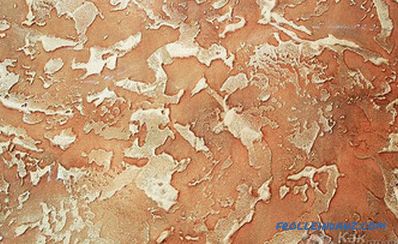 Acrylic Venetian plaster
Acrylic Venetian plaster
Besides the differences in composition, the plaster mix also differs in aesthetic properties. So, there are two groups: structural and textured types. Structural plaster has a white base, so often the final stage is painting. Texture mixtures are divided into 4 main groups depending on the size of the granules:
- large;
- medium;
- small;
- thin.
To choose decorative plaster with high waterproofing and antiseptic properties, choose the options that include thickeners, antiseptics and preservatives.
Benefits and features
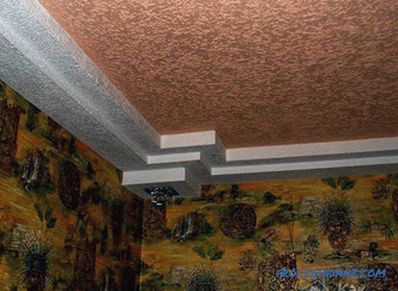 Ceiling plaster with bark beetle
Ceiling plaster with bark beetle
Special components , which are part of the decorative mixture, provide the finishing material with a large number of positive properties and advantages. Among them are several basic ones:
- practicality;
- water repellency;
- antiseptic;
- durability;
- ease of application (all the steps are done by hand, without the assistance of outside help);
- decorating any type of surface;
- masking minor defects;
- environmental friendliness.
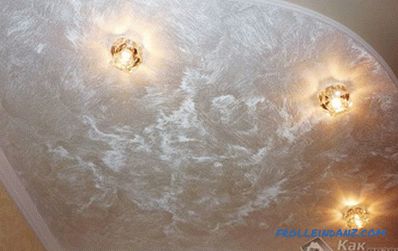 Helps to quickly transform the interior
Helps to quickly transform the interior
An important advantage and positive feature of plaster is the ability to quickly transform interior. Using it, you can create any pattern or pattern, and then paint in the desired shade, which will be combined with the decoration on the walls and ceiling.
When using decorative plaster, it is not necessary to carefully prepare and level the ceiling surface.
The nuances when applying decorative plaster
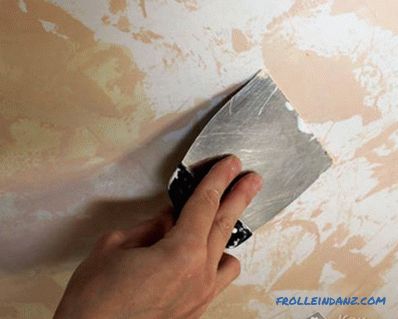 Features of applying
Features of applying
it is recommended to buy the necessary tools for work and paint immediately when purchasing a decorative mixture, if subsequent painting is foreseen. From the tools you will need:
- a spatula of various sizes;
- a perforator;
- a mixing container (bucket);
- poluterki.
If it is necessary to level the ceiling surface, then you can use special fillers or mount a plasterboard construction with an aluminum profile. If you are new to the construction business, you need to carefully consider and study the instructions on how to apply decorative plaster on the ceiling.
It is also worth considering a few nuances that will improve the desired result:
- The ceiling must be clean and dry (this will prevent the appearance of fungus and mold).
- Before application, it is recommended to apply a layer of deep penetration primer and wait until it is completely dry.
- The mixture should be thoroughly mixed using a special construction whisk (there is no need to use high speed for this, as the texture may be damaged).
- The movements when applying decorative plaster are identical to the spackling process (smooth from the bottom up).
- To impart an texture or pattern, it is recommended to use a grater, roller or spatula.
- After applying the plaster should take at least a week, after which you can proceed to the next steps: painting or varnishing. 17
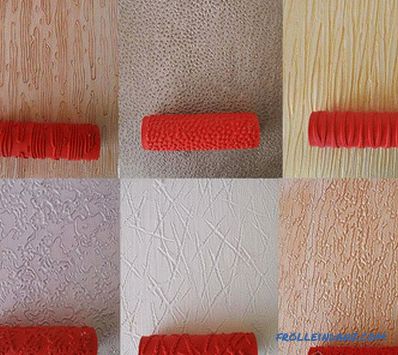 You can use textured rollers
You can use textured rollers
Various techniques are used to obtain a variety of effects. For example, when performing circular movements as a result, you can get a shell pattern.With the help of a plastic float, you can achieve the formation of grooves of different directions.
 Special wax
Special wax
After the plaster has dried completely, you need to wax the surface . This will give the ceiling a glossy effect, as well as add additional protection.
How to work
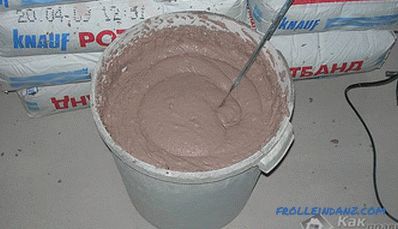 Mixing decorative plaster
Mixing decorative plaster
When applying decorative The composition is recommended to follow simple rules:
-
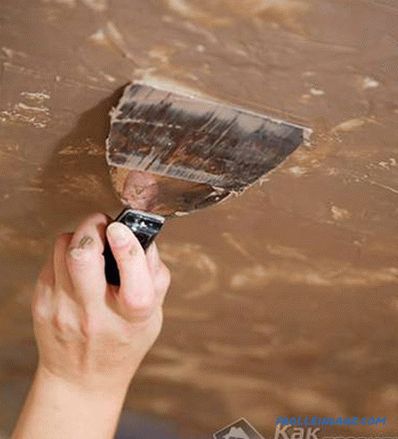 Applying Venetian plaster Before you start, lay the floor with a film, old newspapers or wallpaper, so that the solution is not absorbed in the floor finish.
Applying Venetian plaster Before you start, lay the floor with a film, old newspapers or wallpaper, so that the solution is not absorbed in the floor finish. - Dilute the dry mixture correctly. For this, it will be sufficient to follow the recommendations and instructions indicated on the package. It is desirable to use warm water. As a result, the consistency should turn out like thick sour cream.
- Apply plaster with a spatula, and roll it with a roller. If we are talking about fine-grained compositions, then the construction sprayer is also suitable.
- The plaster layer must not exceed 5 mm, but must not be less than 2 mm.
- Application method - cross-brush strokes. It is necessary to work very quickly and without interruptions, as the decorative layer dries quickly enough. If the walls are covered with excess plaster, they can be cleaned with a spatula and a damp, soft cloth.
- Start at the corner of the room and continue along the wall. When the first lane is fully ready, you can proceed to the next.
- Depending on the type of plaster used to decorate the ceiling, the principle of application may differ. Thus, the standard composition (modeling plaster) requires an instant drawing of a pattern using a notched trowel. When working with textured compositions, the formation of the pattern occurs automatically.
If you doubt your abilities or do not have the necessary amount of time, it is better to trust with professional experts or choose another type of finish.
Now we can make small conclusions and summarize. Decorative plaster in our time is the most popular type of finish. With its help and a little fantasy, you can transform the ceiling beyond recognition in a few days and at the same time hide small errors in the surface. As a result of the work done, the room will daily delight you with its beauty.
See also:
How to make a plasterboard ceiling
How to finish the ceiling with clapboard
Seal the seams on the ceiling
Video
You can get acquainted with the technique of applying decorative plaster on the ceiling below:
